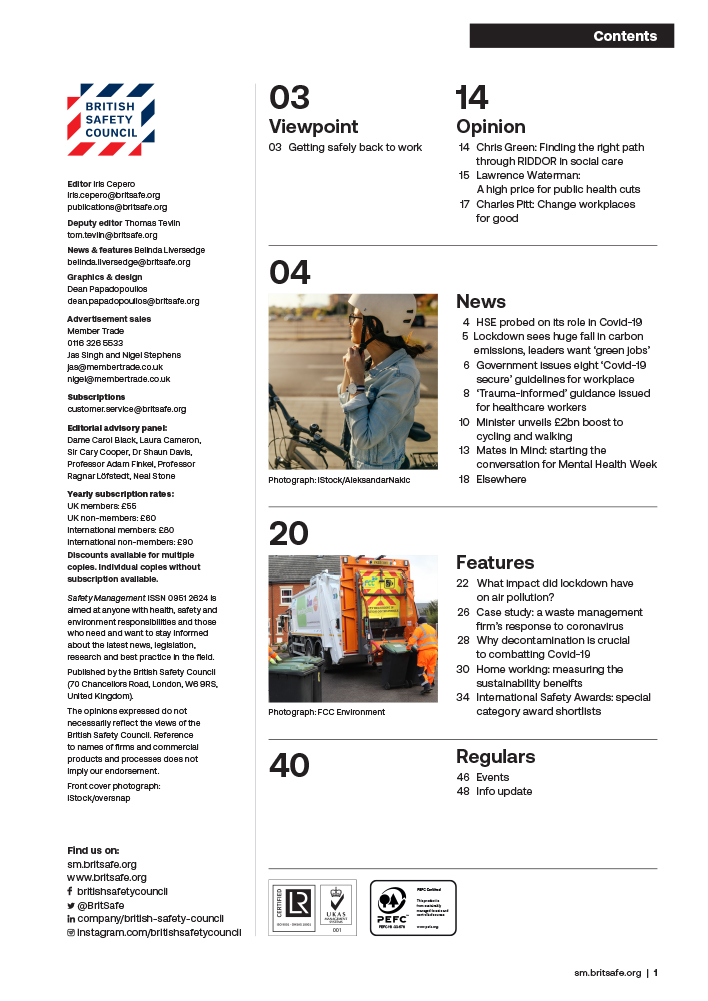The Sentencing Council Health and Safety Offences, Corporate Manslaughter and Food Safety & Hygiene Offences Definitive Guideline (‘the Guidelines’) came into force nearly 10 years ago. The Guidelines sought to implement a proportionate approach to sentencing, ensuring that the levels of fines imposed are proportionate to the means of the offender and reflect the seriousness of the offence committed. This article will explore the sentencing process, provide an update on sentencing over the years and will explore some recent cases.
Opinion
Sentencing for health and safety offences: how the level of fines is rising
Sentencing process
The Guidelines provide a tariff-based structure with specific starting points and ranges for fines. This gives judges a framework to use when arriving at a fine for sentencing. The first step of the process is to assess the overall seriousness of the offence by considering culpability and risk of harm, rather than just the actual harm caused. In terms of culpability, the Court must balance the different factors to reach a fair assessment of the offender’s culpability. This ranges from low culpability, which are minor failings or an isolated incident, to very high culpability, which is a deliberate breach or flagrant disregard of the law. In terms of harm, this is determined by the creation of risk of such harm, consideration of the seriousness of the harm risked by the offender’s breach and the likelihood of that harm arising.
 Photograph: iStock/_ultraforma_
Photograph: iStock/_ultraforma_
The Court should then also consider two key factors in assigning the final harm category: i) whether the offence exposed a number of workers or members of the public to the risk of harm, or ii) whether the offence was a significant cause of actual harm. The Court must then consider moving up a harm category if one or both of these factors apply. Determining the offence category is therefore crucial as it significantly affects the fine, given that different offence categories have significantly different starting points and ranges of fine.
The size of the organisation is also very important, which is determined by the company’s annual turnover and identifying whether the company is a micro, small, medium, large or a very large organisation. This information then helps establish a starting point for the fine. For example, a ‘Micro’ organisation, which has a turnover of less than £2 million, would face a starting point of £250,000 and a range of £150,000 to £450,000 if convicted based on harm category 1 and very high culpability. Whereas a ‘Large’ organisation would face fines starting at £4 million and a range of £2.6 million to £10 million for a similar offence.
Understanding a company’s annual turnover is crucial in establishing the fine to be imposed, and any judge is ultimately limited by the range prescribed here. For ‘very large organisations’ the Guidelines do not specify a range for a fine. This does create some challenges for sentencing judges as they are required to ensure that a fine is proportionate while still ensuring the fine has a sufficiently severe impact on a company to stress the importance of health and safety. The lack of direction in the Guidelines around this point has led to different approaches being taken by different judges.
 Polly Geddes is an associate solicitor at Pinsent Masons. Photograph: Pinsent Masons
Polly Geddes is an associate solicitor at Pinsent Masons. Photograph: Pinsent Masons
For all sizes of company, the Court is required to consider mitigating and aggravating factors and adjust the proposed fine accordingly. Entering a guilty plea allows for a third reduction of a fine.
Courts are also keen on ensuring that the initial proposed fine, which is based on the organisation’s turnover, is still sufficient to bring home the importance of health and safety to the decision makers.
Health and Safety Executive statistics
Prosecutions for health and safety offences fell in 2022/2023 but inspections increased. The Health and Safety Executive (HSE) carried out 216 criminal prosecutions for breaches of health and safety with a 94 per cent conviction rate. This is down from 290 prosecutions in 2021/22.
The conviction rate suggests HSE is only willing to bring cases to prosecution where it is confident that it has sufficient evidence to support its case. The lack of appetite for risk taking in bringing prosecutions is notable in this statistic and highlights the need for companies to ensure that they are taking reasonably practicable steps around health and safety and making every effort to ensure that, if an incident did occur, the HSE would not have sufficient evidence against them to bring a successful prosecution.
Recent fines
Over the last few years, we have seen a gradual increase in fines being handed down by sentencing judges. We have summarised some of the biggest health and safety fines from the last 12 months as follows:
BAM Nuttall Limited – £2.3m fine
In June 2024, BAM Nuttall Limited, a civil engineering contractor supporting both public and private sectors, was found guilty of breaching section 2(1) of the Health and Safety at Work etc. Act 1974 following the death of an employee who drowned in a river. The company was fined £2.3 million and ordered to pay £25,770.48 in costs at Leeds Magistrates’ Court on 12 June 2024.
 Hannah Burton is an associate solicitor at Pinsent Masons. Photograph: Pinsent Masons
Hannah Burton is an associate solicitor at Pinsent Masons. Photograph: Pinsent Masons
HSE held that BAM Nuttall Limited failed to plan the work, failed to carry out an adequate risk assessment and did not introduce suitable safety measures nor a safe system of work.
Stateside Foods Limited – £800,000
One of the UK’s largest producers of supermarket pizzas was fined £800,000 after two workers suffered serious injuries at a factory in Bolton. In 2020, there were two separate incidents in which employees were caught in the machinery.
One man had his arm drawn into an inadequately guarded conveyor belt on 8 January 2020. Following this, a colleague had part of his hand drawn in between a roller and conveyor belt on 14 October 2020.
Stateside Foods Limited pleaded guilty to breaching sections 2(1) and 3(1) of the Health and Safety at Work etc. Act 1974 and was fined £800,000 and ordered to pay £8,340 costs.
Stark Building Materials (Jewson) – £400,000
National builders’ merchant Jewson has been fined £400,000 for a string of lapses in failing to manage asbestos safely at their Middlesbrough branch. The prosecution was brought by Middlesbrough Council following concerns being raised regarding damaged asbestos-containing materials. An inspection of the site led Environmental Health Officers to identify a number of damaged asbestos-containing materials and asbestos fibres were found to have been released.
Through the investigation it was found that between 2004 and 2019, despite many surveys being carried out, there had been a significant failure to properly inspect and manage asbestos at the premises.
Jewson pleaded guilty to breaching section 3 of the Health and Safety at Work Act 1974 at the first hearing and was fined £400,000.
David Lloyd Leisure Club Limited
In August 2023, David Lloyd Leisure Club Limited received a £2.55 million fine and was ordered to pay £258,355 in costs at Leeds Crown Court, following a guilty plea to section 3 of the Health and Safety at Work etc. Act 1974. A prosecution was brought by Leeds City Council following the death of a three-year-old who was visiting the leisure club with his dad and sister when he was found in the swimming pool. The prosecution found that there were inadequate lifeguarding arrangements in place with a 17-year-old expected to supervise 50 swimmers.
On 1st August 2023, David Lloyd Leisure Club Limited pleaded guilty to the offence relating to the company exposing club members to ongoing risks between September 2015 and April 2022. The company admitted to having inadequate and unsuitable risk assessments in place and had previously been subject to a fine of £330,000 for an earlier ‘near miss’ incident in 2016 where a child was found in the water of a different club.
The judge imposed a fine of £2.9 million having applied the Guidelines. This was reduced to take account of the guilty plea entered by David Lloyd Leisure Club Limited.
Summary
Since the introduction of the Guidelines, we have seen a sharp and consistent increase in health and safety fines being given to companies. The focus by the courts remains to stress to companies the importance of introducing adequate measures to promote effective health and safety practices. Over the coming years, we expect to see fines continue to increase, particularly in respect of very large organisations where the court is not bound by the restrictions in the sentencing guidelines.
Polly Geddes and Hannah Burton are associate solicitors at Pinsent Masons law firm. Contact them at:
Health and Safety Offences, Corporate Manslaughter and Food Safety and Hygiene Offences Definitive Guideline can be found at:



